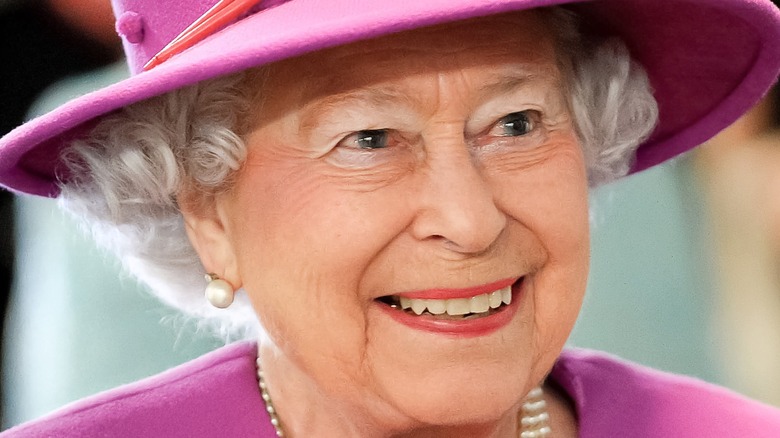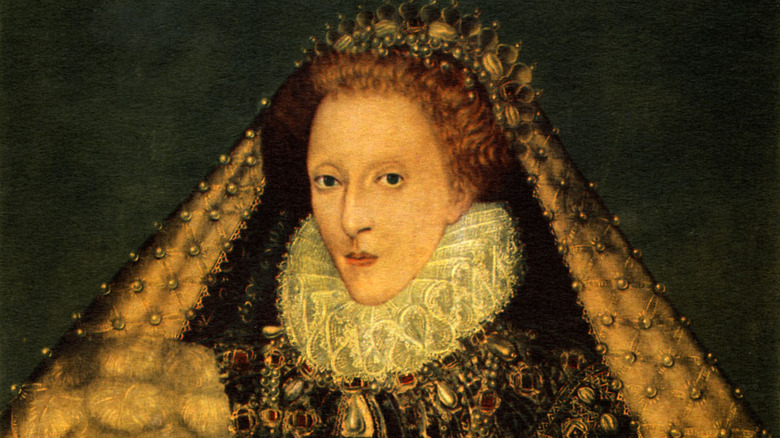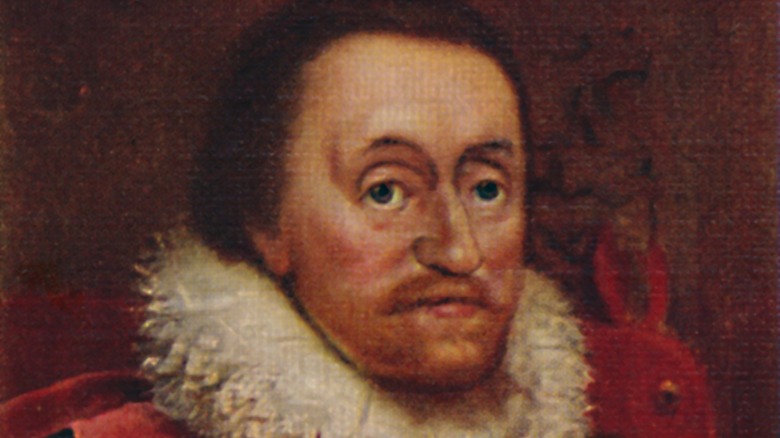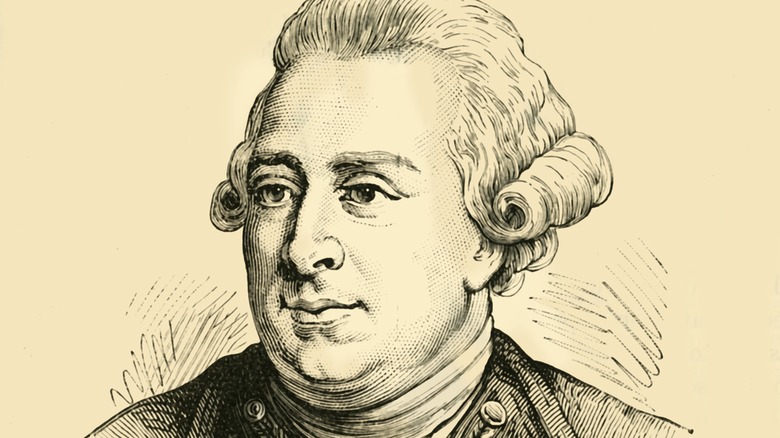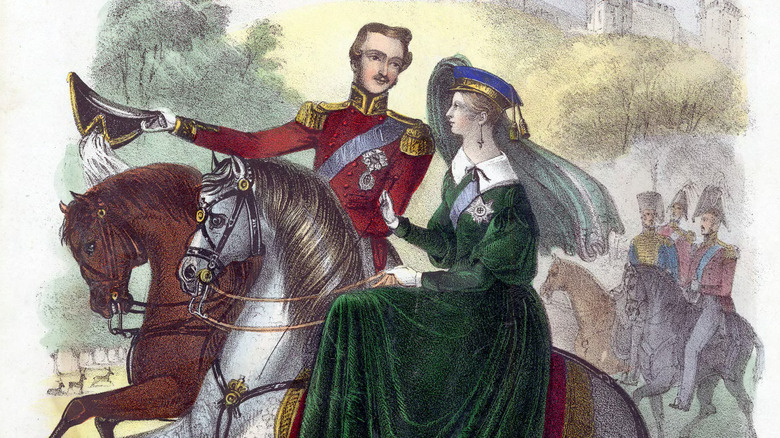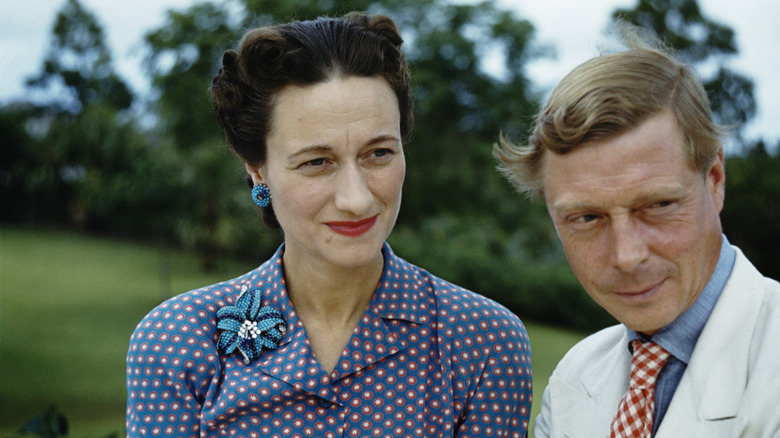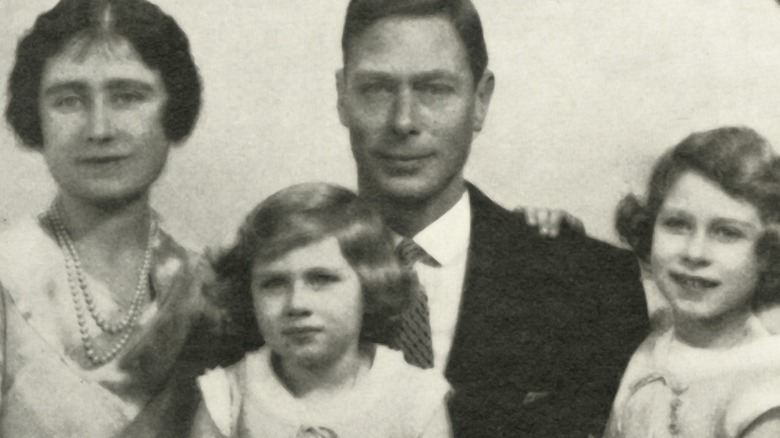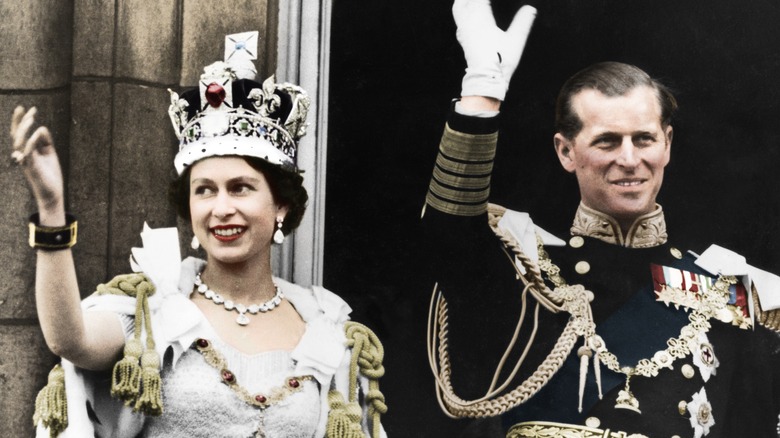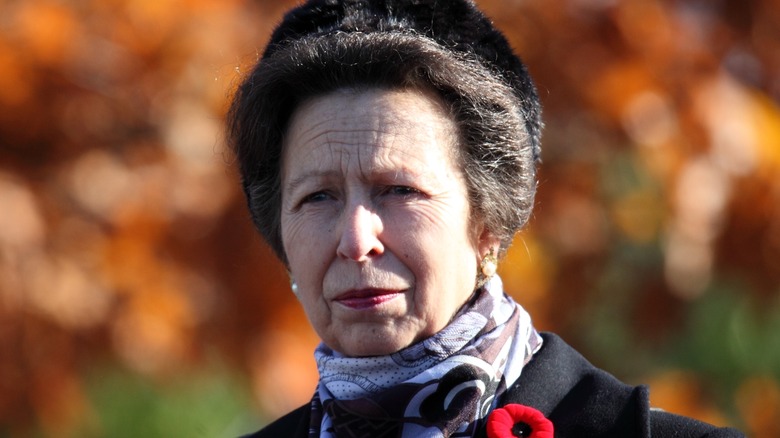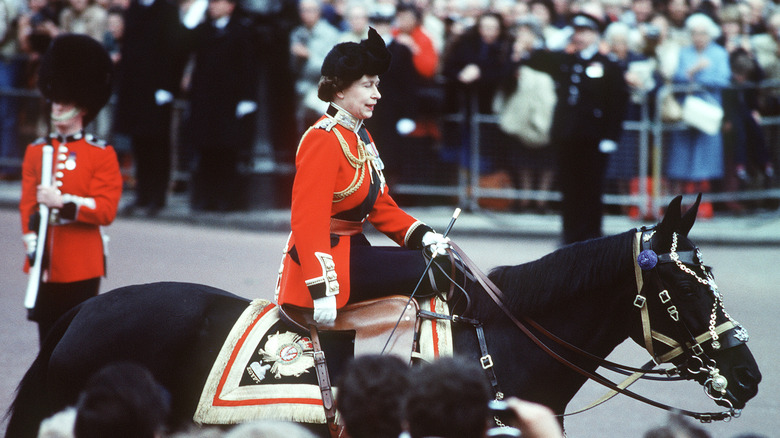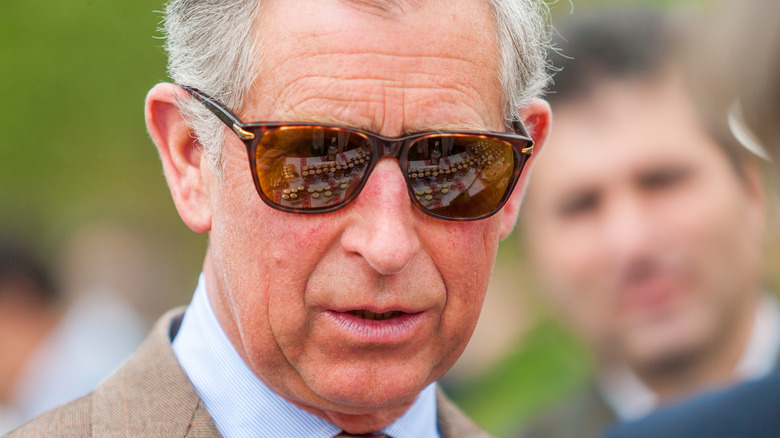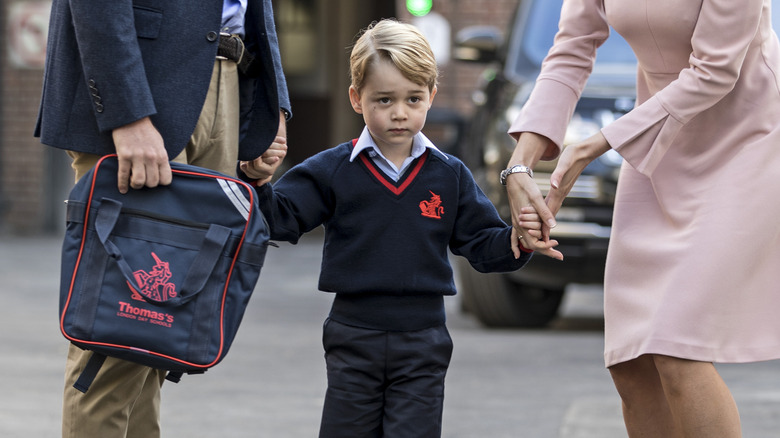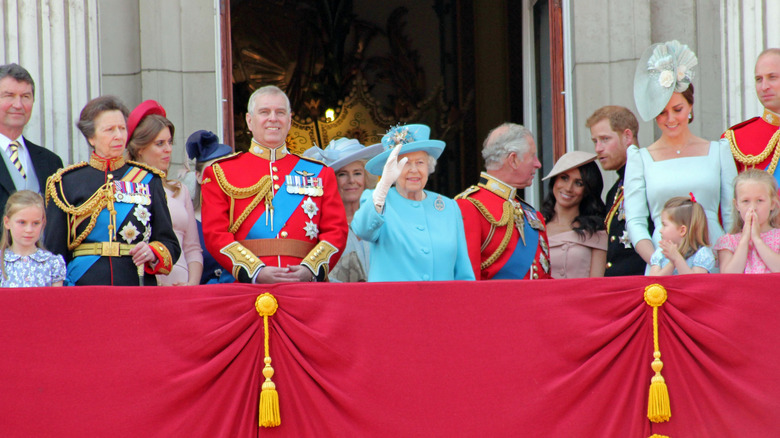Times People Tried To Assassinate Members Of The British Royal Family
Few events leave a more indelible impression on a nation than the assassination of a leader. People in the United States still talk about where they were when President John F. Kennedy died and whether or not they watched the horror of November 22, 1963, live on television (via the John F. Kennedy Library). And the same goes for the shooting of President Ronald Reagan on March 30, 1981, according to the Ronald Reagan Presidential Library & Museum. Reagan would later famously comment, "Getting shot hurts."
But assassination attempts are nothing new across the pond. The British royal family has faced off against them for centuries with commanding stoicism and courage. The list of potential assassins has ranged from rival royalty to bomber pilots and outright loons. But the golden thread running through these attempts remains the undaunted and incredible way the royals have handled themselves even as they stared death in the face.
This statement proves no less true in the 21st century than in the 15th century. Here's everything you need to know about the times people tried to assassinate members of the British royal family and how the royals responded.
Queen Elizabeth I
During her 45-year-long reign, Queen Elizabeth I faced numerous assassination attempts, but the most famous of these precipitated the execution of her cousin, Mary Stuart, Queen of Scots (via The Royal Family). The Tudor dynasty's last ruler, Elizabeth converted England back to her father Henry VIII's new Anglican religion when she took the throne. She acted as head of the church, which bred many enemies within the Vatican and Catholic nations. These individuals considered her an illegitimate ruler because of her faith. They wanted her gone so that a Catholic ruler, such as the Queen of Scots, could be installed in her stead.
Reigning in tumultuous times meant Elizabeth faced many assassination attempts, including those with direct ties to Mary Stuart, whom she imprisoned for two decades, per History Hit. While Elizabeth initially remained resolute about not executing her cousin, the discovery of the Babington Plot changed everything. This assassination plot involved plans for a foreign invasion followed by the cold-blooded murder of Elizabeth. Mary Stuart would be installed on her dead cousin's throne.
Elizabeth learned of the plan through Sir Francis Walsingham, her spymaster general. He had double agents assigned to Mary Stuart's household. These agents feigned allegiance to Mary, encouraging her to start hatching her third assassination plot against Elizabeth. Although Mary played coy about masterminding it all, she eventually signed her own death warrant with the words, "Let the great plot commence." Mary was beheaded in 1587 (via History), and Elizabeth reigned for 16 more years.
James VI and I
Because Queen Elizabeth never married and had no heirs, Mary Stuart's son, James VI and I (he was the sixth King James of Scotland and the first of England, and gets both numbers since they were still different countries then), succeeded the last Tudor monarch in 1603 (via Royal Central). Raised Protestant, he spent much of his youth distancing himself from his Catholic mother. So, it didn't take much finagling to convince Elizabeth he was the man for the job. He also laid claim to the English throne through his great grandmother, Margaret Tudor, which helped iron out the two-decade squabble between Elizabeth and Mary Stuart.
James VI and I is best known for what many Christians consider among the most authoritative translations of the Bible. So, you may be wondering who would want to murder him. The list proved long, especially for Catholics who sought greater religious tolerance. A group of these men, led by Robert Catesby, planned to blow up Parliament and the king on November 5, 1606, by placing kegs of gunpowder in the cellar of a building beneath the House of Lords, according to History.
Fortunately, the plan hit a snag when Guy Fawkes, one of the would-be assassins, was discovered in the cellar piling 36 kegs of gunpowder high. Fawkes and his fellow conspirators faced torture, trial, and brutal executions for the assassination plot. The execution saw them hanged, drawn, and quartered. That said, Fawkes managed to escape the last two of the three punishments by jumping from the gallows resulting in a broken neck.
King George III
In the late 1700s, Great Britain faced everything from inflation to national debt, food shortages to war, as explained in Dana Rabin's "The End of Excuse? James Hadfield and the Insanity Plea." Unhappiness and dissatisfaction in the realm translated into a handful of assassination plots against King George III.
According to Stockton-on-Tees, they included an attack on August 2, 1786, when Margaret Nicholson approached the monarch carrying what looked like a rolled-up scroll. Assuming it was a petition, King George III accepted it only to have an ivory-handled dessert knife revealed. She stabbed the sovereign repeatedly, but the blade proved so dull it did no damage. The king graciously asked law enforcement to treat her mercifully as she was mentally unwell and had not done him any harm.
But this wouldn't be the last time that a person attempted to take his life. On May 15, 1800, James Hadfield opened fire on King George III during the national anthem at Drury Lane Theatre, per the British Newspaper Archive. After missing the monarch, Hadfield was arrested. He spent the rest of his life in an asylum declared "criminally insane," per "The Trial of James Hadfield for High Treason: In the Court of King's Bench." Hadfield's case led to the Lunatics Act and the concept of criminal insanity, explains Joel Elgen in "Witnessing Insanity: Madness and Mad-Doctors in the English Court."
Queen Victoria and Prince Albert
Queen Victoria and Prince Albert saw many assassination attempts during their lifetimes, as reported by History. The popular British monarch survived eight different plots, with the Prince Consort often by her side. One of the most shocking was Edward Oxford's attempt to shoot Queen Victoria and Prince Albert on May 29, 1842, four months after their wedding. (Victoria was four months pregnant at the time.)
Within 100 yards of Buckingham Palace's gates, on their daily ride in an open carriage through Hyde Park, Oxford shot at the Queen and Prince Consort with a dueling pistol. Fortuitously, when the shot rang out, Victoria turned to see some passing horses, a move that saved her life. But the baby-faced assassin had not yet finished. He fired a second gun, but Victoria ducked, successfully avoiding this new assassination attempt. The crowd, now alerted to Oxford's presence, wrestled him to the ground.
Although most people would flee back to the palace, Queen Victoria and Prince Albert continued on their jaunt as if nothing had happened. Albert later recalled, "We took a short drive through the park, partly to give Victoria a little air, partly also to show the public that we had not, on account of what had happened, lost all confidence in them" (via History Collection). This unflappable courage in the face of death is something Victoria and Albert passed down to the following generations.
Edward VIII
Controversy surrounds the reign and abdication of King Edward VIII right when Great Britain needed a strong leader most, per The Guardian. His royal exit would later get played up as a transcendent story of love and sacrifice to marry the American socialite and divorcee Wallis Simpson.
Since that time, much has come to light regarding Edward VIII and Simpson's Nazi sympathies and just how much they had to do with the pressure to abdicate. But Edward's VIII short career as the king might have proved even briefer had a plan by George Andrew McMahon (a.k.a. Jerome Bannigan) of Ireland to murder him been successful.
McMahon's assassination attempt occurred during a military parade through Hyde Park on July 16, 1936. Eyewitnesses remember him as a short and burly man wearing a brown suit and carrying something in one hand and a newspaper in the other, which he tapped against his leg as the royal procession moved closer. King Edward VIII rode on horseback leading six battalions (per The Irish Times) and wearing a bearskin hat and scarlet tunic, making him an easy target. As he passed by, the little, brown-suited man's newspaper dropped to the ground revealing a firearm. The crowd reacted quickly grabbing his arm and yelling for help. After his detainment, McMahon admitted harboring Nazi sympathies and said he "only did it as a protest."
George VI and his family
During WWII, a German pilot bombed Buckingham Palace destroying portions of the royal residence and narrowly missing King George VI and Elizabeth, as reported by History Extra. The Windsors survived two more bombings that week and nine direct hits in five years. They took this in stoic stride, refusing to flee as many European royals did. This tough-as-nails approach helped the British royal family regain lost esteem after the abdication of Edward VIII from the throne.
It bonded the royals with their people as they all shared the same burden of fighting a German war machine that had no qualms about attacking civilians. Queen Elizabeth expressed her sympathetic feelings, saying, "I am glad we have been bombed. It makes me feel I can look the East End in the face" (via History Extra). In an even gutsier move, Elizabeth refused to take the royal children, Princesses Elizabeth and Margaret, and flee London.
In the face of so many assassination attempts by the Nazis, George VI and Elizabeth toured the damaged areas of their palace exuding a courageous resolve. Newsreels lauded the couple's steadfastness while blasting curses down upon Germany for their attempts to take out the royals. The media also reinforced the everyman nature of their king and his family by reporting on the clothing coupons and ration books they used. They also showed Princesses Elizabeth and Margaret leading normal lives despite the dangers they faced and even knitting various items for British soldiers.
Queen Elizabeth II and Prince Philip
Some royal assassination attempts are stranger than others, as the so-called Lithgow Plot illustrates (via The Sydney Morning Herald). It occurred in 1970 during a tour of Australia by Queen Elizabeth II and Prince Philip. During one leg of their tour, they rode a train through the countryside, nearly facing derailment. Officials had carefully inspected the route from Sydney to Orange in advance, but someone placed a large log on the tracks at the last minute.
According to Clifford McHardy, who investigated the case at the time, the log measured more than six to seven feet in diameter and had the potential to do severe damage, as reported by ABC News. In other words, it could've had deadly consequences, especially if the conductor had traveled at his standard speed. It could've led to a devastating crash and derailment, resulting in an untold number of casualties.
Fortunately, the conductor chose to travel much slower that day, perhaps on account of the precious cargo he bore. Although the train did strike the log, the reduced speed kept it on the tracks. If this plot isn't ringing a bell, it's because the Aussie government felt so embarrassed by the whole debacle that they kept it under wraps for years, hoping to avoid egg on the nation's face.
Princess Anne
Some assassination plots remain clandestine for years, while others can't be concealed. Take the attempted kidnapping of Queen Elizabeth's daughter, Princess Anne, on March 20, 1974, as reported by Smithsonian Magazine. Like Queen Victoria and Prince Albert, Princess Anne rode in a car with her new husband of four months, Captain Mark Phillips (via Brides). At roughly 8:00 pm, the couple headed back to Buckingham Palace from a charity event when a white Ford Escort pulled forward, blocking the maroon Rolls-Royce limo just 200 yards from the palace.
An unemployed London laborer named Ian Ball, 26, emerged from the white vehicle with two handguns, per People. He charged the back of the limousine, shooting an officer in the right shoulder as he went. He would later shoot the same man two more times, as well as the limo driver. Eventually, Ball got a hold of Anne's arm, and her husband grabbed onto her waist. As the two men played tug-of-war over the princess, she had a very unpleasant conversation with her would-be assailant.
The commotion of the event brought law enforcement reinforcements. Soon, Ball was taken into custody. Although we can only guess at his ultimate intention, police later found valium tranquilizers, handcuffs, and a ransom letter to Queen Elizabeth II in his car. Initially reported as an assassination attempt, Ball would later claim he only meant to kidnap Princess Anne.
Queen Elizabeth II
British royals must stay in the public eye. It's paramount to their job but a responsibility that comes with inherent risks. Military parades represent an especially difficult security threat as policing massive crowds gets complicated quickly. An example of this is the case of Marcus Serjeant, 17, as reported by the BBC.
In 1981, during the iconic Trooping the Color, Queen Elizabeth II rode down the mall on her 19-year-old steed, Burmese. As the sovereign turned down Horseguards' Parade, six shots rang out from the crowd. Only 36 years earlier, her uncle King Edward VIII had faced off against another gunman a mere half-mile away. Although the six blanks Serjeant shot startled Elizabeth II's horse, she remained remarkably stoic (via Biography). Video featured in a BBC documentary about the Queen shows her calming the startled steed with a couple of pats.
In the meantime, law enforcement and guardsmen dropped Serjeant to the ground, taking him into custody. Prince Charles recalled that day without much surprise regarding his mother's level-headed reactions. In his interview for the BBC documentary, Prince Charles noted that Queen Elizabeth II "has a marvelous way with horses. She's made with strong stuff." The strong stuff no doubt began with the example her set parents as they faced off against Nazi fighter pilots throughout World War II.
Prince Charles
During a 1994 trip to Sydney, Australia, Prince Charles stood before the masses to present Australia Day awards when gunfire erupted, as reported by the Mirror. Like his mother, Charles would remain as cool as a cucumber as a would-be assassin, David Kang, 23, was wrestled to the ground by the prince's bodyguards. Unfazed and smiling, he adjusted his cufflinks taking the event in stride as he continued with the ceremony.
As with the log on the railroad tracks, the Aussies were horrified by the attempt on Charles' life. And the government immediately began downplaying the situation. Paul Keating, the prime minister of Australia, claimed, "The important thing to record about this is that it was not an assassination attempt. It was a political demonstration" (via the Mirror). In court, Kang would second this with a defense claiming he acted to bring attention to the plight of Cambodian boat people, according to The Sydney Morning Herald. Kang also reportedly suffered from mental health issues, including bouts of depression.
Unlike most of the assailants on this list, Kang has transformed his life. He now works as a barrister in New South Wales and has expressed regret over his past. But he also makes it clear that he's moved on with his life. In Kang's defense, it should be noted that he only fired blanks.
Prince George
Prince George remains one of the cutest little royals on the planet. Yet, his natural charm and adorableness haven't thwarted Islamic State terrorists from targeting him (via News 18). Fortunately, United Kingdom forces intercepted the messages, which were encrypted and sent on the Telegram app. The man sending the messages, Husnain Rashid, of Nelson, Lancashire, eventually confessed to the terror plot and several others targeting Prince George.
Rashid also encouraged so-called lone-wolf attackers to come after the tiny Windsor on his way to and from school, according to The Guardian. Among his most frightening posts was an image of Prince George's school with two jihadist fighters in masks superimposed on top. The picture included the address of the school and the ominous wording, "Even the royal family will not be left alone. School starts early."
But the threats didn't stop there. Rashid also exhorted fellow terrorists to target people in football stadiums, Wimbledon, the 2017 election, and more. Millions of would-be criminals may have seen his incendiary posts. He also spent plenty of time applauding others for violent acts of terror worldwide. Fortunately, no evidence exists showing others took his lead, but the messages remain chilling. They also point to the dangers faced by the royal family in the 21st century due to globalism, the internet, and easy travel access between nations.
Various Royals
Not all plots to assassinate the British royal family get hatched by lone actors. And not all these plans get hatched in Great Britain or its overseas realms. Events in 2015 illustrated these two points. It started with the discovery of a plot by Islamic State terrorist Reyaad Khan, 21, of Syria, to target various British royals (and the crowds watching them) as they gathered to celebrate VJ Day (via the Telegraph). British and American intelligence agencies spent months tracking Khan before determining he presented a significant security risk to the British people and Royal family.
Before his radicalization, Khan was a student with straight As who lived in the Riverside part of Cardiff, according to The Guardian. He even fostered hopes of becoming Great Britain's first prime minister of Asia decent. But then the 21-year-old came into contact with ISIS extremists online. Soon, he traveled to Syria and participated in terrorist training videos where he advocated for brutal violence against the public.
He even solicited sponsors for a suicide bomber's explosive belt, and he showed images of dead bodies that he, working with ISIS, claimed responsibility for. To neutralize the threat, the British Royal Air Force (RAF) targeted him via a drone strike in August 2015. He was getting in a car at the time of his death, per the Telegraph.
